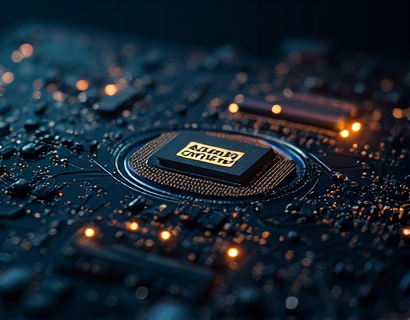Unlocking Stable DeFi: Smart Contract Solutions for Pegged Token Creation and Seamless UCASH Exchange
In the rapidly evolving landscape of decentralized finance, or DeFi, the integration of smart contracts has emerged as a pivotal technology for creating stable digital currencies pegged to leading tokens. This innovation not only enhances the stability and flexibility of digital assets but also facilitates seamless bidirectional trading, setting a new benchmark for financial tools in the digital economy. By leveraging the power of smart contracts, developers and users can create secure, efficient, and user-friendly solutions that redefine the way we manage and trade digital currencies.
Stablecoins, digital currencies designed to maintain a stable value relative to a specific asset or set of assets, have gained significant traction due to their ability to mitigate the volatility associated with traditional cryptocurrencies. However, the process of creating and managing stablecoins has traditionally been complex, involving centralized entities and trust-based systems. The advent of smart contracts has democratized this process, allowing for decentralized and autonomous management of stable digital currencies.
Smart Contracts and Stablecoin Creation
Smart contracts are self-executing contracts with the terms of the agreement directly written into code. They run on blockchain networks, ensuring transparency, immutability, and security. In the context of stablecoin creation, smart contracts automate the process of pegging a digital token to a stable asset, such as the US dollar or gold, without the need for intermediaries.
The creation of a stablecoin using smart contracts involves several key steps. First, a reserve asset is deposited into a smart contract, which acts as a custodian. This reserve asset serves as the backing for the stablecoin. The smart contract then generates a corresponding amount of stablecoin tokens, which are stored in user wallets. The entire process is designed to ensure that the number of stablecoins in circulation is always proportional to the reserve asset, maintaining the peg.
One of the most significant advantages of using smart contracts for stablecoin creation is the elimination of trust issues. Traditional stablecoins rely on a central authority to manage the reserve and ensure the peg, which can lead to risks such as fraud or insolvency. Smart contracts remove this central point of failure, as the peg is enforced by the code itself, making the system more transparent and trustless.
Bidirectional Exchange Mechanisms
Seamless bidirectional trading is crucial for the adoption and utility of stablecoins in DeFi applications. Users need to be able to convert stablecoins to their underlying asset and vice versa with minimal friction. Smart contracts facilitate this by providing automated and trustless exchange mechanisms.
A bidirectional exchange smart contract allows users to deposit stablecoins to receive the corresponding reserve asset and vice versa. The contract ensures that the exchange rates are always in line with the peg, and it automatically adjusts the reserves and token balances accordingly. This automation not only speeds up the exchange process but also reduces the risk of human error and manipulation.
For instance, a user can initiate a withdrawal of stablecoins by sending the stablecoin tokens to the exchange smart contract. The contract verifies the user's balance and the current exchange rate, then releases the equivalent amount of the reserve asset. Conversely, to deposit the reserve asset and receive stablecoins, the user sends the asset to the contract, which checks the reserve levels and issues the corresponding stablecoins.
Enhancing Stability and Flexibility
The use of smart contracts in stablecoin creation and bidirectional exchanges significantly enhances the stability and flexibility of DeFi ecosystems. Stability is ensured through the automated peg maintenance, where the smart contract continuously monitors the reserve asset levels and adjusts the token supply to maintain the one-to-one ratio.
Flexibility is another key benefit. Smart contracts enable the creation of various types of stablecoins pegged to different assets, allowing for a diverse range of financial instruments. This flexibility supports a wide array of DeFi applications, from lending and borrowing to decentralized exchanges and yield farming, all of which require stable and reliable assets.
Moreover, the decentralized nature of smart contracts means that these stablecoins can operate independently of central authorities, reducing regulatory risks and increasing accessibility. Users from around the world can participate in DeFi protocols without the need for traditional financial intermediaries, fostering a more inclusive and global financial system.
Technical Implementation
Implementing smart contracts for stablecoin creation and bidirectional exchanges involves several technical considerations. First, the choice of blockchain platform is crucial. Platforms like Ethereum, Binance Smart Chain, and Solana offer robust smart contract capabilities, but each has its own set of features and limitations.
On Ethereum, for example, the ERC-20 standard is commonly used for token creation, while ERC-721 and ERC-1155 support more complex token functionalities. The choice of blockchain also impacts transaction costs, speed, and scalability. For high-frequency trading and large-scale operations, blockchains with faster transaction times and lower fees, such as Binance Smart Chain, may be more suitable.
Once the blockchain and token standards are selected, the smart contract code must be developed. This typically involves writing the contract in Solidity for Ethereum or Vyper for Ethereum 2.0, and deploying it on the chosen network. The contract includes functions for depositing and withdrawing assets, managing reserves, and executing exchanges. Security audits are essential to identify and mitigate potential vulnerabilities in the code.
To ensure seamless user experience, the smart contract should be integrated with user-friendly interfaces, such as decentralized applications (dApps) built on frameworks like React or Vue.js. These interfaces provide a intuitive way for users to interact with the smart contract, performing actions like depositing, withdrawing, and exchanging assets without needing to understand the underlying code.
Use Cases and Applications
The applications of smart contract-based stablecoins extend beyond simple pegged tokens. In DeFi, these stablecoins serve as a stable medium of exchange, store of value, and collateral for various financial products.
One prominent use case is in decentralized lending and borrowing platforms. Users can lock their stablecoins as collateral to borrow other cryptocurrencies or fiat assets. The smart contract ensures that the collateral remains above a certain threshold, automatically triggering liquidation if the value drops below the required level.
Decentralized exchanges (DEXs) also benefit from stablecoins, as they provide a stable trading pair for users to execute trades without the risk of significant price fluctuations. This stability is particularly important for arbitrage strategies and hedging against market volatility.
Yield farming is another area where stablecoins play a crucial role. Users can deposit stablecoins into liquidity pools to earn interest or participate in automated market making (AMM) protocols, where stablecoins are used to facilitate trading without traditional order books.
Challenges and Considerations
While smart contract-based stablecoins offer numerous advantages, there are also challenges and considerations that need to be addressed. One of the primary concerns is the security of the smart contracts themselves. Any vulnerabilities in the code can be exploited, leading to loss of funds or disruption of the peg.
To mitigate these risks, thorough audits and testing are essential. Open-source code allows the community to review and contribute to the security of the smart contracts. Additionally, implementing best practices in coding and following established security standards can further enhance the robustness of the contracts.
Another challenge is regulatory compliance. As stablecoins and DeFi protocols operate in a relatively uncharted legal space, navigating regulations can be complex. Developers and projects must stay informed about regulatory developments and ensure that their smart contracts comply with relevant laws and guidelines.
Interoperability is also a key consideration. For stablecoins to be widely adopted, they need to be usable across different blockchain ecosystems. Cross-chain bridges and interoperability protocols can help achieve this, allowing stablecoins to be transferred and used on various platforms seamlessly.
Future Prospects
The future of stablecoins in DeFi is promising, with ongoing advancements in smart contract technology and blockchain infrastructure. Scalability solutions like layer 2 protocols and sharding can significantly reduce transaction costs and increase processing speeds, making DeFi applications more accessible and efficient.
Moreover, the integration of stablecoins with other DeFi components, such as decentralized oracles and automated protocols, will further enhance the functionality and utility of these digital assets. As the ecosystem matures, we can expect to see more innovative use cases and broader adoption across various industries.
In conclusion, smart contracts are revolutionizing the creation and management of stable digital currencies, offering secure, efficient, and user-friendly solutions. By enabling seamless bidirectional trading and enhancing the stability and flexibility of DeFi, smart contracts are setting a new standard for digital currency management in the modern economy.










































